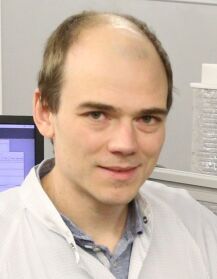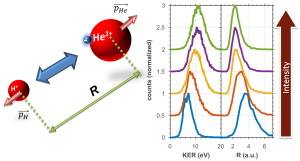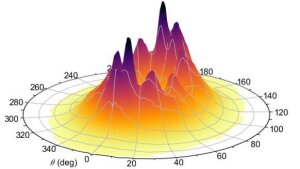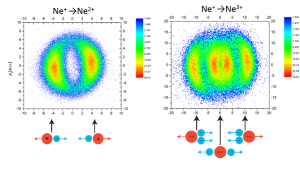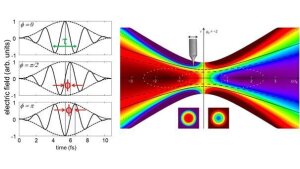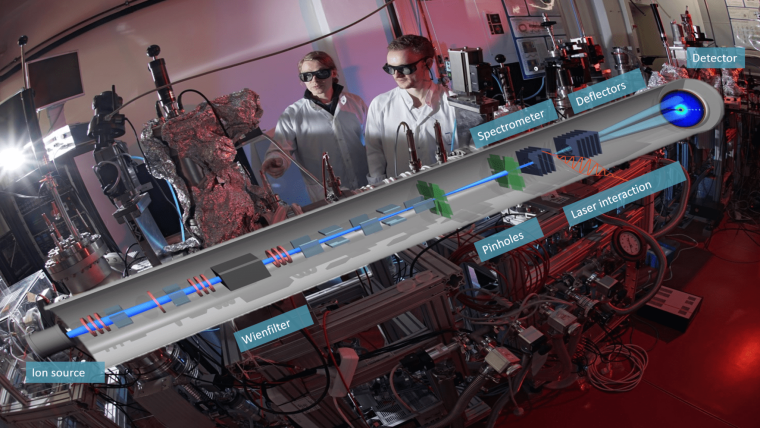
|
This project focuses the control of fundamental single- and two-electron systems using intense, ultra-short laser fields utilizing ionic targets. The use of ions gives access to fundamental systems of laser-matter interaction and allows the observation of fundamental quantum mechanical processes on the femto- and attosecond time scale. |
Heteronuclear Limit of Strong-Field Ionization: Fragmentation of HeH+ by Intense Ultrashort Laser Pulses
Intensity-dependent KER distribution of HeH+-ionization by 800nm laser pulses
Grafik: FSU Jena / IOQIn this work the first experimental investigation of the simplest asymmetric molecule, the helium hydride ion(HeH+), in strong laser fields was performed. Helium hydride is only stable as an ion and, therefore, an ion beam apparatus is required for its investigation.
This study focused on how the asymmetric structure, and the resulting permanent dipole moment of the HeH+, influence the laser-induced fragmentation.
Both experiment and theory for ionization of HeH+ and the isotopologue HeD+ reveal, that direct vibrational excitation, with almost no electronic excitation as the initial process, dictates the fragmentation process.
PHYSICAL REVIEW LETTERS 121, 073203 (2018)
Coherent Control at Its Most Fundamental: CEP-Dependent Electron Localization in Photodissociation of a H2+ Molecular Ion Beam Target
Visualization of the electronic probability density in the molecular frame
Grafik: FSU Jena / IOQWe demonstrated coherent control of electron localization and the fragmentation rate in the simplest molecule, with essentially a single optical cycle. Localization of the electron with respect to the two nuclei is controlled via the CEP of the ultrashort laser pulses.
In contrast to previous CEP-dependent experiments with neutral molecules, the dissociation of the molecular ions is not preceded by a photoionization process, which strongly influences the CEP dependence. The phase dependence is determined by a single-shot phase measurement correlated to the detection of the dissociation fragments.
The experimental results show quantitative agreement with ab initio 3D time-dependent Schrödinger equation calculations that include nuclear vibration and rotation.
PHYSICAL REVIEW LETTERS 111, 093002 (2013)
Multiphoton light-induced molecular potentials
Measured momentum distribution for dissociation of H2 in a tailored laser field
Grafik: FSU Jena / IOQUsing femtosecond laser pulses, one can manipulate the forces acting on the constituents of a molecule. This makes it possible to shape the potential energy landscape on which the nuclei of a molecule move and, thus, control chemical reactions. Key to this control are tailored laser fields, which can be generated by superimposing phase controlled laser pulses of multiple colors. We have demonstrated that this approach gives rise to surprisingly complex dynamics, even in simple molecules. This complexity results in the strongly structured dissociation pattern shown in Figure I.
This project aims at creating new shapes of tailored laser fields in order to explore routes to controlling simple chemical reactions. We utilize a high-repetition rate fiber laser and the coincidence ion beam apparatus. Data is acquired with an ion beam source (see below) with three-dimensional imaging detector.
M. Kübel, et al., Nature Communications 11, 2596 (2020)
Momentum resolved study of the saturation intensity in multiple ionization
Ion momentum distribution after single and double ionization of a Ne+-ion beam
Grafik: FSU Jena / IOQUsing elliptically polarized laser fields the measured ion momentum distribution after single ionization exhibits a characteristic shape providing direct and complete information on the ionizing field strength as well as the ionization time.
Subsequently, after double ionization the ion momentum distribution is a convolution of the momenta of two electrons. Corresponding to the different emission directions a four- peaks structure appears in the momentum spectra of the ions.
We developed a deconvolution method which can be used to reconstruct the electron momenta in order to retrieve the averaged ionization times of all charge states created in the laser focus after multiple ionization with up to four ionization steps.
PHYSICAL REVIEW A 91, 031401(R) (2015)
Carrier-envelope phase effects and measurement
(left) few-cycle laser pulse with different values of the CEP. (right) Distribution of the CEP
Grafik: FSU Jena / IOQIn very short laser pulses consisting of only a few optical cycles, the position of the maxima of the carrier wave relative to the pulse envelope, becomes an important parameter for applications in attosecond science. Figure 1 (left) illustrates how the carrier-envelope phase f determines the shape of a few-cycle laser pulse. Our group has a long standing history of developing techniques for the measurement of f, utilizing strong-field ionization.
For example, we have collaborated with scientists from the Unviersity of Erlangen in order to measure the CEP distribution in the focus of an intense laser pulse. In this experiment, a nanoscale metal tip was used as a phase sensitive probe to map out the phase distribution throughout the laser focus.
Figure 1 (left) illustration of a few-cycle laser pulse with different values of the carrier-envelope-phase (CEP). (right) Distribution of the CEP, obtained from our measurements.
- Hoff, et al. Tracing the phase of focused broadband laser pulses. Nature Phys13, 947–951 (2017)
- Zhang, et al., "Single-shot, real-time carrier-envelope phase measurement and tagging based on stereographic above-threshold ionization at short-wave infrared wavelengths," Opt. Lett. 42(24), 5150–5153 (2017).
- Rathje, et al., "Review of attosecond resolved measurement and control via carrier–envelope phase tagging with above-threshold ionization," J. Phys. B 45(7), 074003 (2012).
